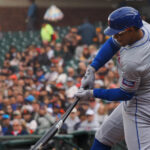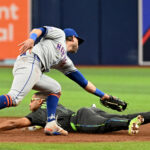Whenever there is a discussion about General Manager’s talents with regards to a rebuilding team, it often seems like the amateur draft is a measuring stick used, and it’s used improperly.
Perhaps it is because the General Manager is seen as the face of the franchise in terms of decisions to be made, but in reality, the General Manager has little to do with the amateur draft.
Case in point, if the GM was the one making the selections, then why isn’t he in the room the entire day of the draft? If the GM is the one making the selections then why do teams hire a Director of Amateur Scouting?
I assure you the Director of Amateur Scouting has more to do with the draft than the General Manager, if not, then he wouldn’t have the role he has.
With the Mets, you’ll often find that many wish to compare “Omar Drafts” to “Sandy’s Draft.”
First, you cannot evaluate an amateur draft after 6 months. You can try, but you’re just spinning your wheels if you do.
Second, as Nick Pugliese pointed out on Saturday, the most successful draft during Minaya’s tenure was in 2005. We know that now in 2012, so it took about 7 years to draw that type of conclusion. In 7 years, I doubt Alderson will be the GM of the Mets.
Does a GM have a say? Yes.
Especially on a 1st round talent, but the General Manager isn’t the one scouting these players. He isn’t the one reading every single scouting report on every one of the amateur players available. That’s the Amateur Scouting Director’s job.
I wonder if you as a fan believe Omar drafts Parnell in the 9th round, if you do then what do you think the Director of Amateur Scouting does for a living?
Let me share a link for you
This is a Q & A with new Cardinals Amateur Scout Director Dan Kantrovitz.
To take some excerpts from it:
“I think we have the ability to compete at the Major League level on a consistent basis, and in this position, I have an opportunity to contribute to that. If you are passionate about scouting, which I am, there is no better way to contribute to a team’s sustainable success than being tasked with leading the Draft.”
“We have, however, already discussed our scouting strategy as well as our Draft-related analytics, and I’d imagine both will be tweaked. But I don’t think you will notice any radical changes.”
“The way we look at it is, there is a risk/reward profile associated with every player at every point in the Draft. If you take on more risk, then the player should have a higher upside, or ceiling, if everything works out. Philosophically, I would not be averse to taking on additional risk if our scouts present a compelling argument as to why a particular player has a realistic chance of reaching that higher upside. But just because we have quite a few early picks this year doesn’t mean each pick shouldn’t be as well-founded as if we just had one”
Question: If it’s possible to sum up in a few sentences, what general philosophies and strategies underline your view of drafting amateur players?
“From a scouting standpoint, we will focus on players with a high ceiling who have a chance to make an impact in the Major Leagues. For a position player, that might be an athletic, “toolsy” player with good baseball instincts. For a pitcher, that might be a guy with a loose arm, natural delivery, command of the strike zone and some movement on his fastball. At the end of the day, we will line up the Draft board based on our projection of a player’s potential future contribution.”
This is why he’s hired. He’s hired to make the best possible amateur draft selections for the health of the Not John Mozeliak, but Dan Kantrovitz.
From 2006 until DePodesta was hired, Rudy Terrasas was responsible for the Mets draft. Not Omar Minaya.
In 2005, Russ Bove was responsible for the Mets draft…not Omar Minaya. Was Omar the buck stops here guy? Maybe. But was he the one scouting and saying “pick this guy” No.
Here’s a quote for you from Bove.
“In 2005, myself and Damon Oppenheimer took a bunch of (junk) in New York because we didn’t take [Craig] Hansen, the reliever from St. John’s,” said Bove, who only served as the Mets scouting director for one year, despite being responsible for ultimately giving the Mets three big leaguers [Mike Pelfrey, Jonathan Niese, and Bobby Parnell] even though they didn’t have a second or third round pick that year. “Now, where are all of those guys [who criticized us]? It takes time to evaluate a draft.”
I think people like to look at GM’s and say “they drafted this guy” because it makes their own argument for liking one guy and disliking another.
However, an owner’s willingness or unwillingness to spend on amateur talent probably has more influence on the draft than the GM does to be honest.
After the 2008 season, Milwaukee Brewers Director of Amateur Scouting Jack Zduriencik was hired to take over the Mariners as General Manager. When the Brewers had success in the 2008 season their General Manager Doug Melvin said, “No doubt about it, he deserves almost all the credit for the young players we have. The players he has drafted are making an impact at the big league level.”
An Amateur Scouting Director is an apparent thankless job with fans. The General Manager gets the credit on the surface when he in fact has little to do with the players selected.
If you’re looking to evaluate the drafts of the past, and the drafts of the future, you need to look past the General Manager and look more closely at the person making the actual draft decisions.












